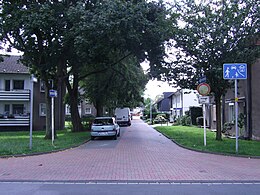Traffic-free area
A traffic-calmed area , colloquially often also called play street , less often residential street and also known as residential road , is a street or traffic area in Germany that is signposted with traffic sign 325.1 . The area is used for traffic calming in built-up areas . The first model projects have been implemented since 1977. The official introduction to the StVO took place in 1980.
Road traffic regulations
The traffic-calmed area is announced by the traffic sign 325.1 and canceled by the traffic sign 325.2.
The following applies within this area:
- Pedestrians are allowed to use the entire width of the street; Children's games are allowed everywhere.
- Vehicle traffic must keep walking pace.
- The vehicle drivers must neither endanger nor hinder pedestrians; if necessary they have to wait.
- The pedestrians must not unnecessarily obstruct the traffic.
- The parking is prohibited outside the specially marked area, excluding for boarding or alighting, for loading or unloading.
- In a traffic-calmed area, according to a ruling by the Dortmund Regional Court, you do not have to expect to be overtaken.
- According to a decision of the Cologne Higher Regional Court of May 30, 1997 (Az .: Ss 136/97 (Z)), parking is also permitted in a traffic-calmed area within the marked parking areas in the left-hand direction, even if the traffic-calmed area is neither a one-way street Rails are still laid there on the right-hand side, since a traffic-calmed area is not a lane as defined in Section 12 (4) StVO , but a special area without a lane.
When driving out of a traffic-calmed area, a risk to other road users is to be excluded according to § 10 StVO . As when driving out of a property, you have to wait for all other road users, right-before-left does not apply. According to the case law of the Federal Court of Justice, this is even the case if up to 30 meters have to be covered between the traffic sign "End of the traffic-calmed area" and the main road.
Administrative regulations
The marking of traffic-calmed areas presupposes that the roads in question, in particular through speed-reducing measures by the road construction agency or the road construction authority, have a predominantly residential and development function. This means that the traffic-calmed area must be structurally designed in such a way that the typical character of a street with a lane , sidewalk and bike path does not prevail. As a rule, this is achieved by leveling expansion (paving), planting beds, mutual parking spaces, plateau paving and constrictions (see also shared space ).
Controversial are cost "locks", such as speed bumps , ramp bricks and concrete - planter . They affect the overall visual appearance and can be dangerous for cyclists , the elderly and disabled people and hamper emergency vehicles.
Through traffic and trucks -Transport are not forbidden to the traffic-calmed area is thus not a neighboring street. In order to keep through traffic out of the areas or streets, the following measures can also be taken:
- often dead ends are created.
- entry is only permitted from one side.
- the residential road is divided by a pedestrian zone , such as B. in Maximilianstrasse (Regensburg) .
Related concepts
Related concepts are the residential street in Austria, the meeting area in Switzerland, France and Belgium and the traffic-calmed business area in Germany. In contrast to the traffic-calmed area, where you can only drive at walking speed and motor vehicle drivers and pedestrians have equal rights, the following apply:
- in the encounter zone Tempo 20 and priority for pedestrians
- Also higher speeds in the traffic-calmed business area (it belongs to the 30 km / h zone under traffic law )
- in the residential street in Austria ( at the same traffic sign! ) a passage ban
- Shared Space : describes a planning philosophy according to which the public street space dominated by motor vehicle traffic should be made more livable, safer and the flow of traffic should be improved. Characteristic is the idea of doing without traffic signs, signal systems and lane markings. At the same time, road users should be given full equality, whereby the right of way rule continues to apply. In contrast to conventional traffic calming, it should also be possible to use it in main roads.
- Woonerf : a traffic calming concept developed in the Netherlands in the 1970s. Street spaces in predominantly urban residential areas are created as mixed traffic areas and given a special design. Pedestrian and motor vehicle traffic are not clearly separated and must take each other into account.
In contrast to all of the above concepts, the play street is closed to vehicles of all kinds.
See also
literature
- Frank Höfler: Transport Practice, Volume 1: Transport Planning . Bauwerk Verlag, Berlin 2004, ISBN 3-934369-52-9 , p. 231 ff .
Web links
Individual evidence
- ↑ a b c Annex 3 of the Road Traffic Regulations (StVO). Section 4 “Traffic Calmed Area”. Retrieved September 23, 2016 .
- ↑ Judgment of the LG Dortmund from September 26, 2005, Az 17 S 131/05
- ↑ Order of the Cologne Higher Regional Court of May 30, 1997 - Az.:Ss 136/97 (Z)) Das Verkehrslexikon. Retrieved August 28, 2017.
- ↑ BGH, November 20, 2007 - VI ZR 8/07. Retrieved March 30, 2016 .


